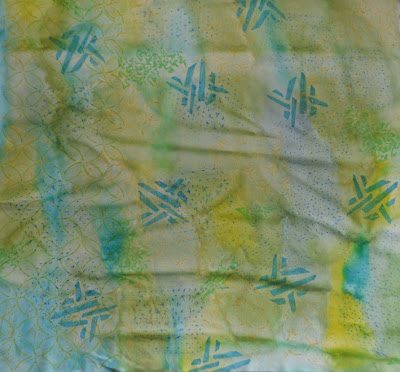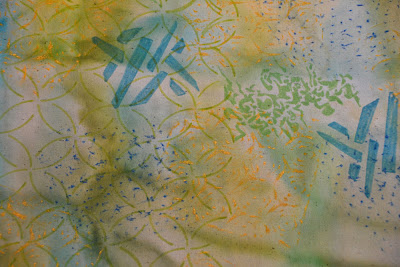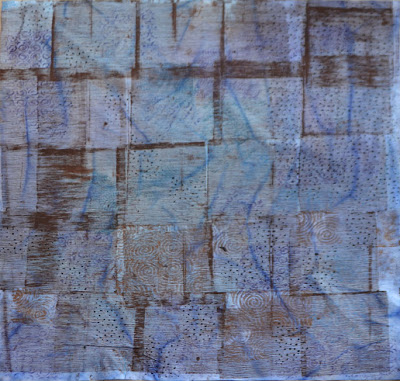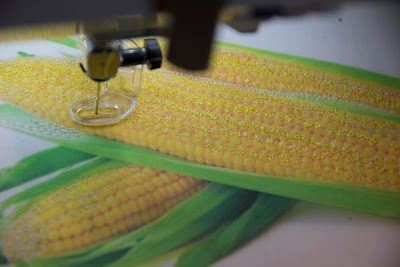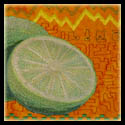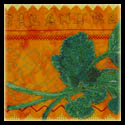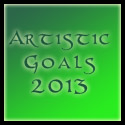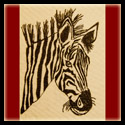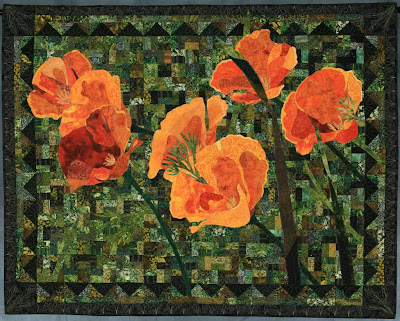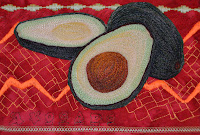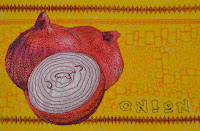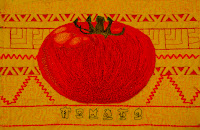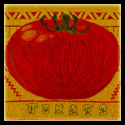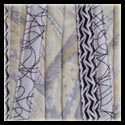 |
| Christina standing below hand-dyed embroidery threads |
I’m back from five days in “stitch heaven” with Gail Harker. The class, “Experimental Hand Stitch” focuses on Procion MX dyeing of embroidery thread and a wool/acrylic felt to stitch on, and then learning some of the basic embroidery stitches and how to use them in a contemporary context.
 |
| My friends”, Debbie and Rebecca, dyed felts and threads |
The felt and threads are vibrant and beautiful. Gail feels that having your materials inspire you is important, so she helps her students understand their color choices and combinations to be successful with the dyeing process.
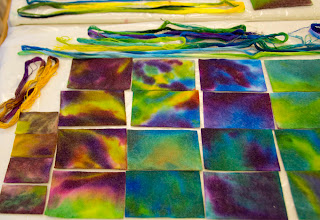 |
| Some of my dyed felts and threads |
I basically stuck with an analogous color scheme from yellow-green through red-violet. If you’re unfamiliar with analogous color schemes, it means that you pick colors that are adjacent to each other on the color wheel. So the colors I worked with were greens, blues, and violets.
After our dyeing days, we started doing small stitch samplers. Each stitch will have its own page in a small stitch book (we even learned how to bind our books!) We also worked on documenting our samples within a sketchbook, including what threads we used, any observations we have, needles that were chosen, etc.
 |
| Some of my incomplete pages with the sketchbook documentation pages and sample threads |
Some of our samples were also worked on sketchbook pages which we dyed and then fused together, so they are quite stiff. We then poked holes in the sketchbook pages along the line which we wanted to stitch, and then added the stitch afterwards. It was so fun… it reminded me of when I was a little girl and had cards with pictures on them and holes to “stitch” through (really it was more like lacing.)
 |
| French Knots (in process) by Christina Fairley Erickson |
While none of these samples is complete yet, you can get an idea of what they’ll look like here. I have additional ones started, but these are the most complete. The other thing which was different and interesting was the freedom which we were encouraged to take with each piece. For instance, in years past, French knots were expected to have the thread wrapped neatly around the needle two times. With contemporary hand stitching, however, we can make a variety of sizes and different textures and effects by wrapping a thread more times around the needle, or by wrapping it loosely, rather than tight.
 |
| Running Stitch (in process) by Christina Fairley Erickson |
 |
| Seed Stitch (in process) by Christina Fairley Erickson |
 |
| Blanket Stitch by Christina Fairley Erickson |
 |
| Open Chain Stitch (in process) by Christina Fairley Erickson |
Each of the pages is about 5″x 7″, so they fit in well with my 5 x 7 Challenge! I’ll be getting my final Salsa piece finished up this week, then I’ll need to work on the sashing and binding of all the Salsa blocks into a finished quilt.
You Might Also Be Interested In:
 |
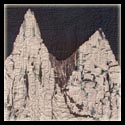 |
 |
| Dyeing to Embroider; | Recognizing our Limits & Not Giving Up |
Hand Stitch Variations |
Check Out these other Great Blogs:
Anything Goes – Quilt ‘n Sew at Stitch by Stitch




















